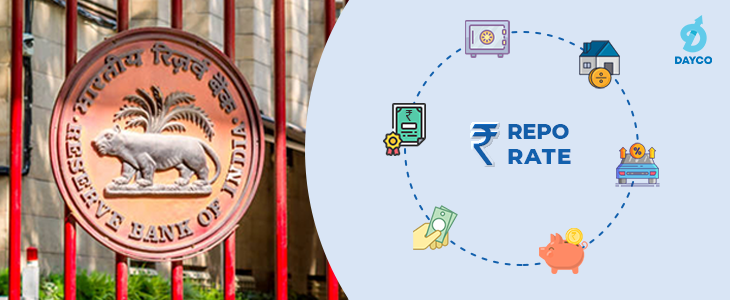Earlier this week, RBI conducted an off-cycle MPC (Monetary Policy Committee) meet and announced a 40 basis points (0.4%) repo rate hike on Wednesday to calm inflationary pressures. The hike is the first since August 2018, and the new Repo Rate now stands at 4.4%. Also, this was an unscheduled meeting of the MPC, the first of its kind held to increase rates. The committee usually meets six times in a financial year, i.e., every two months. The monetary policy determines the quantity of money available in the Indian economy and the mediums through which the money is supplied.
The monetary policy is a crucial policy measure through which the RBI (Reserve Bank of India) aims to control, manage, and influence inflation, the economic growth of our country, the rate of consumption and the overall money supply in the economy. Some of the major tools or instruments through which it does this are Repo Rate, Reverse Repo Rate, Cash Reserve Ratio, Statutory Liquidity Ratio, Bank Rate, and Open Market Operations.
In this blog, we’ll look at the Repo Rate, one of the crucial rates of the monetary policy.
What is Repo Rate?
Repo rate is the interest rate RBI charges to lend money to commercial banks. The Repo rate sets the benchmark for almost all interest rates in the economy. The rate directly affects interest rates on deposits, home loans, car loans, and other borrowings. The interest you earn on your fixed deposits, recurring deposits, small savings schemes, fixed income securities, and savings accounts are also directly affected by this crucial rate. Hence an upward revision is good news for savers and risk-averse investors but not for everyone—more on this below.
How does it impact the economy?
As pointed out earlier, RBI leverages monetary policy instruments (one of them being Repo) to control the money supply, credit availability and inflation rates in the economy. Since the rate is the benchmark for the country’s interest rates, a rise or fall in Repo directly affects all other rates in the economy. A higher Repo increases the cost of borrowing for banks. Banks are the primary source of credit in an economy. Since banks borrow at higher rates from the RBI, they consequently borrow less and increase their lending costs as their margins are hurt.
In turn, this affects the amount of funds available with banks to lend, and higher loan rates on top of it give rise to credit scarcity in the economy. Businesses rely on loans to grow, and without a cheap and affordable credit supply, they can only grow so far. This situation restricts the money supply required for advancing economic activity. So what’s the point in increasing the rates when it hampers the economy? –– to bring inflation within target levels.
Controlling money supply ––Increasing money supply (decreasing Repo) or reducing the money supply (increasing Repo) goes both ways. Before understanding this further, let’s see what a decrease in Repo does.
A decrease in Repo decreases the cost of borrowing for banks. As banks borrow at lower rates from the RBI now, they borrow more and lower their lending costs to end customers. As loans are available cheaply in the market, businesses borrow to expand and invest in larger capital projects. Businesses boom and create employment, and this, in turn, puts larger disposable income in the hands of the people. This cycle is the perfect recipe for upward per capita income and good GDP growth figures. Essentially, very good for the economy.
However, a higher supply of money in the economy increases demand. People have more money in their hands– they demand and spend more. This gives rise to inflation– an increase in the prices of goods and services. Hence, a prolonged period of lower interest rates and accommodative monetary policy gives rise to inflation woes– precisely what’s happening in India right now. Therefore, RBI strikes a balance between economic growth and inflation when deciding on monetary policy measures.
If the inflation figures aren’t in the RBI’s target, the bank decides to increase Repo as there is a need to control the rise in prices of goods and services in the economy. But as mentioned earlier, this comes at the cost of economic growth. Similarly, when the inflation is well under control and economic growth is stalling, RBI decides to cut Repo.
How does the rate impact the markets?
Markets didn’t welcome the rate hike with open hands on Wednesday. Nifty 50 plunged more than 300 points and closed below 16,700, whereas Sensex took a beating of over 1400 points. But why?
Stock markets have an inverse relationship with interest rates. As explained earlier, a lower Repo is perfect for the economy. There is more money in the system as credit is cheaper. If the Repo rates go up, interest rates shoot up, which increases the cost of borrowing for companies. Hence, companies cut back on spending and hold up expansion plans, which directly affects the company’s future cash flows and profits. This results in falling markets. Capital intensive sectors like manufacturing, mining, automotive, airlines etc., are more affected by Repo rate changes than others.
If you have a question, share it in the comments below or DM us or call us – +91 9051052222. We’ll be happy to answer it.
– Nischay Avichal
















